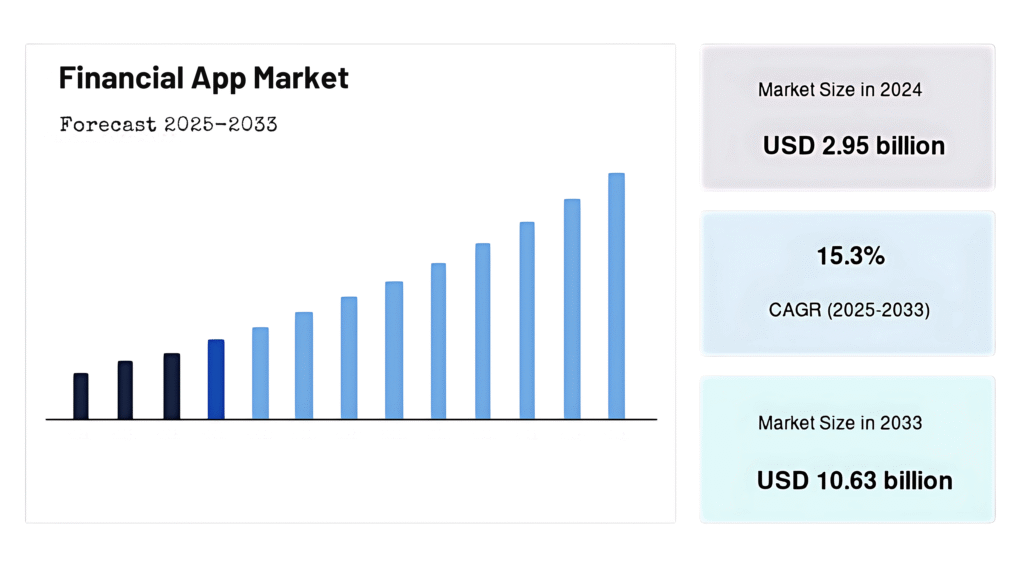Introduction
Your business app isn’t just a tech add-on — it’s one of your biggest investments.
And like any smart investment, you need to know if it’s actually paying off.
That’s where ROI — Return on Investment — comes in.
Done right, tracking your app’s ROI helps you answer critical questions like:
- Are we generating more value than we’re spending?
- What features are driving the most revenue?
- Is our user acquisition strategy sustainable?
Because here’s the truth: even the slickest app design, the most feature-rich build, and the flashiest marketing campaigns won’t matter if you’re not seeing measurable returns.
And you’re not alone if this feels complicated.
Many businesses sink thousands (or even millions) into mobile apps, only to realize a year later that they can’t clearly say whether it was worth it.
No surprise there: ROI for apps isn’t just dollars in, dollars out. It’s a blend of user behavior, platform performance, customer lifetime value, and more.
Now, let’s put this into perspective:
“The global financial app market was valued at USD 2.95 billion in 2024.
It’s expected to grow to USD 3.40 billion in 2025, and an astonishing USD 10.63 billion by 2033.”

That growth means more apps, more user expectations, and a fiercer battle for attention and retention.
So if you’re not measuring ROI? You’re flying blind.
This guide is here to change that.
We’re going to walk you through exactly how to measure ROI for your business app in 2025, with clarity and confidence.
You’ll learn the key metrics, the step-by-step calculation, the tools that make it easier, and common mistakes to avoid.
Whether you’re a startup founder, product manager, or marketing lead, this guide will help you make smarter decisions about your app’s performance and profitability.
Let’s dive in and start measuring what matters.
What is ROI?

Think of ROI — or Return on Investment — like this:
You’re putting time, money, and energy into building your app. ROI tells you if it’s all been worth it.
But when it comes to business apps, the answer isn’t always black and white.
Maybe your app brings in revenue through subscriptions or in-app purchases. Maybe it doesn’t earn money directly, but it helps you retain customers, speed up service, or reduce manual work.
Either way, it’s doing a job, and ROI helps you measure how well it’s doing it.
In simple terms, ROI compares what you’re getting out of the app to what you’re putting in. But here’s where it gets a little tricky with mobile apps:
- The “return” isn’t always about money. Sometimes, it’s about happier customers, smoother operations, or stronger brand loyalty.
- The costs keep going. It’s not just development. You’ve got updates, maintenance, customer support, app store fees, and marketing. Those numbers add up fast.
- Results take time. Your app might not explode in the first few months, but it could become a key driver of growth over time.
So, measuring ROI for your business app is really about zooming out and looking at the full picture.
Is it helping your business grow?
Is it saving you time or resources?
Is it helping you stand out in a crowded market?
If you can’t confidently answer those questions, don’t worry — you’re not alone. Most companies know their app should be performing, but few know how to actually measure whether it is.
That’s exactly what we’ll walk through in the rest of this guide.
But before we get into metrics and formulas, let’s talk about why 2025 makes this more important than ever.
Why Measuring App ROI Matters
Launching a business app is a big move. But keeping it running without knowing whether it’s helping or hurting your bottom line? That’s risky.
In 2025, the mobile app world is evolving faster than ever, and so are the expectations. Users want speed. They expect seamless design. They’re used to smart features powered by AI.
And behind the scenes, businesses are investing in newer technologies like Edge AI, Composable Architecture, and AR and VR trends to stay ahead.
With all this innovation, one question becomes more urgent than ever:
Is your app actually delivering measurable value?
That’s where ROI comes in — not just as a financial metric, but as a tool for smarter decision-making.
When you measure your app’s ROI, you’re able to:
- Understand where your money is going. App development is no longer a one-time cost. From ongoing updates to marketing campaigns, those expenses stack up quickly.
- See what’s working — and what’s not. Maybe your new UI animation is driving engagement, or maybe users are dropping off after the first screen. ROI helps you track these moments with clarity.
- Make better long-term choices. Whether you’re scaling to new regions, planning to integrate mobile app scalability features, or exploring emerging technologies, clear ROI data gives you the confidence to invest wisely.
- Justify investment to stakeholders. Whether you’re reporting to your leadership team or pitching to investors, solid ROI numbers can help make your case.
The reality is this: in a market where user attention is fleeting and the tech stack is constantly shifting, you can’t afford to guess.
Tracking ROI gives you a full picture — not just of profit and loss, but of user behavior, feature impact, and long-term sustainability.
And with tools and frameworks getting smarter, you no longer need a data science team to do it.
In the next sections, we’ll walk through the exact metrics and steps you need to calculate ROI for your app accurately, and in a way that helps you move forward with confidence.
Key Metrics to Measure ROI for Your Business App
Let’s face it – it’s hard to determine if your app is successful if you don’t know what you should be measuring.
You may see downloads increasing, but that doesn’t mean you’re making money.
What if users download the app and never come back? Or worse — what if you’re spending more to get users than they’re worth?
This is where a few key metrics come in. Think of these like your app’s health check. When you track the right numbers, you get real answers — not guesses.
Let’s walk through the most important ones:
- Customer Acquisition Cost (CAC)
This tells you how much it costs to bring in one new user.
It includes everything from ad spend to agency fees to the hours your team spends running campaigns.
Why it matters: If you’re spending $15 to get a user and they only bring in $5 in revenue, that’s a losing game. Understanding CAC helps you set realistic goals and spend smarter.
- Customer Lifetime Value (LTV)
This is the total amount of money a user brings in over the time they use your app, not just the first week, but their entire journey.
Why it matters: A healthy business app usually has an LTV that’s several times higher than the CAC. That means your users are sticking around — and spending.
- Retention Rate
How many people come back after downloading your app?
Are they still using it after a week? A month? Three months?
Why it matters: Apps with poor retention burn through users. High retention means your app is doing something right — it’s useful, engaging, or just plain delightful.
- Conversion Rate
This is the percentage of users who take a key action: sign up, make a purchase, subscribe, or complete a task — whatever your goal is.
Why it matters: It’s one thing to get users in the door. It’s another to get them to act. Conversion rate helps you understand if your app is turning interest into value.
- Average Revenue Per User (ARPU)
Take the total revenue your app has generated, and divide that by the total number of users. That is your ARPU.
Why It Matters: This will give you a better sense of just how valuable each user is, which is useful when you’re building budgets or forecasting growth.
- Churn Rate
This is the percentage of users who stop using your app after a certain period.
Why it matters: A high churn rate can quietly kill your ROI. It’s a signal that users aren’t finding enough value, or something’s broken in the experience.
- App Store Optimization (ASO) Performance
This covers how your app ranks, how many people see it, what kind of reviews you’re getting, and how easy it is to find.
Why it matters: Strong ASO means more visibility. More visibility means more installs — and more opportunities to drive ROI.
A Quick Note
You don’t have to track every metric. Focus on the ones that matter most for your business.
For example:
- If your app’s main job is to drive subscriptions, focus on retention and LTV.
- If it’s a lead-gen tool, zero in on CAC and conversion rate.
How to Calculate ROI of a Business App in 2025
Let’s talk about the part most people avoid — the actual math.
However, the good news is that calculating ROI (return on investment) for your business application can be straightforward.
You don’t need to be a finance analyst, and you don’t need to start with an extensive (even complicated) spreadsheet (though we will show you how to leverage one to take a deeper dive into calculations if you want).
What you do need is clarity on two things:
- What is your app earning or saving for your business
- What’s it costing you over time
Once you’ve got those numbers, the formula is straightforward.
The Basic ROI Formula
Here’s the simple version:

Let’s break that down:
- Net Profit = Revenue the app has generated (directly or indirectly)
- Total Cost = Everything you’ve spent on the app (development, updates, marketing, support, etc.)
Calculating your app’s ROI is not just putting numbers into a formula; it is about keeping track of the right data and interpreting that data into business impact.
Here is your safe, step-by-step playbook for 2025:
Step 1: Define Your App’s Purpose
Why does this app exist? ROI changes based on your goals:
- E-commerce app? Focus on sales conversions.
- Internal tool? Measure time saved for employees.
- Subscription service? Track retention and LTV (Lifetime Value).
Example: A food delivery app’s primary ROI driver is order volume, while a project management tool measures team productivity gains.
Step 2: Add Up ALL Costs (Yes, Even the Hidden Ones)
Most businesses underestimate costs. Include:
- Development costs (design, coding, testing)
- Maintenance & updates (bug fixes, new features)
- Hosting & infrastructure (cloud services, APIs)
- Marketing & user acquisition (ads, influencer campaigns)
- Operational costs (customer support, payment gateways)
Tip: AI-powered tools like AWS Cost Explorer or Google Cloud’s Recommender can auto-track hidden expenses.
Read Also: How Much Does It Cost to Make an App in 2025
Step 3: Measure Revenue & Savings
What tangible value did the app create? Track:
- Direct revenue: In-app purchases, subscriptions, and ad income.
- Cost savings: Reduced manual work, lower error rates.
- Indirect gains: Higher customer retention, brand loyalty.
Example Calculation:
- Total App Cost (1 year): $100,000
- Revenue Generated: $250,000
- Operational Savings (time, efficiency): $50,000
- Net Profit: ($250k + $50k) – $100k = $200k
Step 4: Apply the ROI Formula
ROI (%) = [(Net Profit – Total Cost) / Total Cost] × 100
Using the numbers above:
[($200,000) / $100,000] × 100 = **200% ROI**
(For every $1 spent, you earned $2 back.)
But wait! For subscription apps, factor in Customer Lifetime Value (LTV). If users stay for 2 years or more, the ROI could be significantly higher.
Step 5: Adjust for Intangibles
Some ROI wins don’t fit neatly into formulas:
- Brand authority (e.g., your app is featured in industry reports).
- Employee morale (e.g., teams love using it, reducing turnover).
- Data assets (e.g., user behavior insights that fuel future products).
Pro Tip: Use surveys (e.g., Net Promoter Score) to quantify these.
Step 6: Benchmark & Optimize
- Compare your ROI to industry standards (e.g., SaaS apps average 300%+ ROI).
- Use A/B testing to improve low-performing areas (e.g., tweak onboarding flows).
- Re-calculate quarterly—ROI isn’t static!
Quick Example: A Subscription-Based App
| Item | Value |
| Total Users (Year) | 10,000 users |
| Monthly Subscription Fee | $10/user |
| Annual Revenue | $10 × 12 × 10,000 = $1.2M |
| Total Development Cost | $150,000 |
| Marketing & CAC | $200,000 |
| Maintenance & Support | $100,000 |
| Total Cost | $450,000 |
ROI = [($1,200,000 – $450,000) / $450,000] × 100 = 166.67%
That means for every $1 you spent, your app returned $2.66.
Not bad, right?
Not All Gains Are Direct Revenue
Now, maybe your app isn’t making money directly, and that’s normal for internal tools, support apps, or apps built to boost customer retention.
In that case, your “gains” might look like:
- Reduced support team hours
- Higher customer lifetime value
- Fewer refunds or cancellations
- Faster sales conversions
- Operational cost savings
You can still estimate ROI by assigning dollar values to those outcomes.
For example: If your app helps your support team handle 30% more requests with the same staff, that’s a real savings.
Tips to Make Your ROI Calculation Smarter
- Use actual data, not guesses. Pull numbers from your analytics tools, CRM, billing platform, and team time logs.
- Include all hidden costs. That includes app store fees, downtime, third-party tools, and even hours spent fixing bugs.
- Look at ROI over time. Apps often have high upfront costs but better ROI over the long run. Try calculating over 6, 12, and 24 months.
- Segment by feature or campaign. Want to know if a new feature or UI change was worth it? Track ROI before and after rollout.
Bonus: Create a Simple ROI Tracking Sheet
If you want to keep things organized, here’s a simple table you can use each quarter:
| Metric | Q1 | Q2 | Q3 | Q4 |
| Total Users | ||||
| Revenue | ||||
| CAC | ||||
| Maintenance Cost | ||||
| Churn Rate (%) | ||||
| Net Profit (Gain – Cost) | ||||
| ROI (%) |
It’s a quick way to spot trends and show progress to your team or investors.
Best Tools & Platforms to Measure App ROI
Tracking ROI doesn’t have to feel like decoding a secret spreadsheet or juggling 10 dashboards.
Today, there are powerful tools that do the heavy lifting — helping you track your app’s performance, understand user behavior, and see which parts of your strategy are paying off.
Let’s explore the tools that can make ROI tracking smarter, faster, and honestly… a whole lot less stressful.
- Firebase – All-in-One Analytics for Mobile Apps
Firebase is like a control room for your app. It shows you what users are doing, where they’re dropping off, and what features they love — all in real time.
Why it’s helpful for ROI:
- Tracks custom user events like purchases, sign-ups, or subscriptions
- Offers crash reporting and performance insights (which saves money long term)
- Includes built-in A/B testing to improve conversions
If you’re just starting or want one place to monitor everything from usage to growth, Firebase is a solid first step.
- Mixpanel – Deeper Insight into User Behavior
Mixpanel lets you go beyond basic analytics. Instead of just counting users, you can understand how they interact with your app.
Why it matters for ROI:
- Builds funnels to see where users drop off
- Tracks retention and engagement trends
- Calculates user lifetime value (LTV) and conversion metrics
This is perfect if you’re making frequent product decisions and want real-time insights to guide them.
- Adjust – Track User Acquisition & Ad ROI
If you’re spending money on ads to grow your app, Adjust helps you figure out what’s working.
How it helps:
- Tracks users across multiple ad platforms (like Meta, Google, TikTok)
- Prevents ad fraud, which saves budget
- Shows you the true ROI of each campaign or channel
You’ll know which campaigns are delivering high-value users, and which are just burning money.
- Appsflyer – Advanced Attribution & ROI Dashboards
Appsflyer is a popular mobile attribution platform that’s trusted by big brands. It offers insights into where your users come from and how valuable they are over time.
Why it’s useful for ROI:
- Attribution modeling helps connect ad spend to actual outcomes
- Dashboards show LTV, revenue, and user behavior per channel
- Integrates with marketing tools for smoother reporting
Great if your team runs large-scale campaigns and wants clean, centralized data.
- BigQuery – For the Data-Driven Team
If you’re ready to go beyond dashboards and into advanced modeling, BigQuery gives you the flexibility to ask deeper questions.
Ideal for:
- Custom ROI formulas and long-term projections
- Merging multiple data sources (Firebase, Stripe, etc.)
- Large-scale reporting across business units
This one’s for teams with in-house analysts or developers — but it’s incredibly powerful once set up.
How to Pick the Right Tool(s)
Choosing the right platform depends on where you are in your app journey:
| Stage | Best Tools | What You Get |
| Just launched | Firebase | Core app analytics, performance, and user events |
| Growing user base | Mixpanel + Firebase | Conversion funnels, retention, LTV |
| Running ads | Adjust or Appsflyer | Ad ROI, attribution, campaign analysis |
| Scaling across channels | Firebase + BigQuery or Mixpanel | Custom reports, predictive modeling, deeper ROI view |
Pro tip: Most of these tools offer free tiers or trial versions, so you can test before committing.
Your app generates more data than you think. The key is turning that data into clear, actionable insights.
Whether you’re improving a feature, cutting ad waste, or planning your next launch, the right tools help you track ROI in a way that makes sense for your team.
And once you get comfortable using them? You’ll start making faster, smarter decisions — backed by real numbers, not hunches.
Common Mistakes in Measuring App ROI (And How to Avoid Them)
Measuring ROI is more than just numbers; it is about understanding the value of your app.
Below is a fundamental breakdown of some of the most frequent of these kinds of mistakes and how to avoid them:
| Mistake | Why It’s a Problem | How to Fix It |
| Focusing only on installs | Downloads don’t show true user value. Most users drop off quickly. | Track deeper actions — like purchases, engagement, and retention. |
| Ignoring hidden costs | You’re missing out on costs like support, updates, or ad spend. | Include all ongoing costs when calculating ROI. |
| Measuring ROI too soon | Early numbers can be misleading — users need time to settle in. | Review ROI at 3, 6, and 12-month marks. |
| Using generic metrics | What works for one app won’t work for all. | Customize your KPIs based on your app’s real business goals. |
| Not segmenting users | Averages hide important differences in user behavior. | Break down ROI by user type, traffic source, or geography. |
| Skipping user feedback | Data shows what happened, not why it happened. | Pair your numbers with real feedback from reviews, surveys, or support chats. |
Optimizing ROI: Tips to Improve Your App’s Performance
You’ve done the math and determined where your app lies. Now the fun begins.
Improving your ROI does not have to necessarily mean a complete revamp or spending big bucks on advertising.
Some simple modifications can drive significant change – for example, improve speed, reduce float, and give users an “ear-to-ear, can’t wipe smile off their faces” user experience.
This is how you can improve your app’s ROI without getting overwhelmed:
- Focus on What Users Care About
It’s tempting to chase trends or fancy features, but remember: your users just want things to work well.
Ask yourself:
- What frustrates them?
- Where do they drop off?
- What feature gets them to come back?
Use analytics + real feedback to identify your app’s sweet spots — then double down on what’s working.
- Use Data to Guide, Not Guess
Stop guessing what will move the needle.
Use your analytics stack (like Mixpanel, Firebase, or Amplitude) to find:
- Drop-off points in onboarding
- Features with high engagement
- Churn trends by device, geography, or user type
Once you know where the friction is, you can smooth it out and watch your ROI rise.
- Improve Performance & User Experience
Fast, smooth apps = happy, loyal users.
Things like load times, screen transitions, and responsiveness play a big role in retention.
Not sure where to start? Ask these:
- Does the app load in under 2 seconds?
- Is it intuitive even without a tutorial?
- Are UI animations enhancing or slowing things down?
- Keep It Scalable
As your user base grows, so will your backend demands.
Investing in mobile app scalability and composable architecture now can save you headaches (and money) later.
- Test, Learn, Repeat
Experiment with features, pricing, and UI updates. But don’t just roll them out blindly.
✅ A/B test everything
✅ Track results over time
✅ Be okay with rolling things back if they flop
You don’t have to be perfect — just curious and consistent.
Future Trends in Measuring App ROI
As we progress into 2025 and further, businesses’ ways of measuring app ROI will change. It’s not just downloads and revenue; it’s about long-term value, experience, and adaptability.
Here are some trends you should pay attention to:
- AI-Powered Predictions: ROI will become more proactive with AI forecasting user behavior, churn, and lifetime value.
- Retention & Engagement Over Revenue Alone: Metrics like user retention, session depth, and repeat engagement will matter more than just raw revenue.
- Cross-Platform Tracking: With apps expanding into wearables, AR/VR, and IoT, ROI must cover the entire user ecosystem — not just mobile.
- Experience-Driven ROI: Smooth UI animation, fast load times, and user-centric design will directly impact ROI through better engagement.
- Composable Architecture: Modular app structures will let you measure ROI at a feature or service level, helping you invest smarter.
Conclusion
Let’s be honest — measuring ROI for your business app can feel overwhelming at times.
Data is flying in from every direction, user behavior that changes by the week, and pressure to prove that every feature or campaign was “worth it.”
Notably, imperfection is not a crime here: only intention counts.
It begins with selecting metrics that truly measure your goals, not the so-called vanity metrics. Download? Look past those and into how your users interact with your app, what keeps bringing them back, and what drives them away silently.
ROI is not only about cash; ROI is also about building something that works, scales, and delivers genuine value to both your users and your business.
So take a step at a time:
- Track what matters
- Learn from real data
- Optimize what you can
- And keep evolving
Because in 2025, apps that grow — and win — are the ones that listen, adapt, and measure smarter.
FAQs
- What’s a “good” ROI for a business app in 2025?
It really depends on your goals. For paid apps or SaaS, 4x to 10x returns are solid. For free apps focused on growth, high engagement and retention can be just as valuable.
- Can I still measure ROI if my app is free?
Definitely! ROI isn’t just about money — it’s also about user growth, time spent, referrals, and even product feedback that drives your business forward.
- How long should I wait before tracking ROI?
Give your app at least 3 months post-launch to stabilize. Early data helps, but real trends need time to surface.
- What tools do most companies use to measure ROI?
Top picks include Firebase, Mixpanel, Amplitude, and App Annie. Most of them offer free tiers to get started.
- Do UI/UX updates really affect ROI?
Absolutely. Small design improvements — like smoother navigation or better onboarding — can lead to major jumps in retention and conversions.







